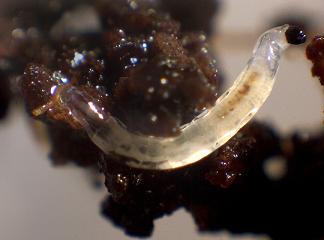Add Your Heading Text Here
Fungus Gnats and Nematodes

.
.
Beneficial Nematodes
Nematodes (or roundworms, phylum: Nematoda) are one of the most diverse of all animals — and very difficult to distinguish — with over 80,000 identified and up to half a million undescribed. They are highly adaptive, being seen in every every ecological niche around the world, found in locations as diverse as Antarctica and oceanic trenches.
“Nematoda” means “the thread-like ones”, from Ancient Greek, representing a unique and highly distinct lineage. With respect to agriculture, depending on the species, a nematode may be beneficial or detrimental to plant health. From a horticultural perspective, there are two categories of nematode: predatory ones, which target root-zone pests, and pest nematodes, which attack plants. Here at Global Horticultural, we have the following predatory nematodes available:
Quick Facts on Beneficial Nematodes
- Nematodes can survive in the root zone of plants for 2 to 3 months prior to entering the host insect. (Most pests spend a portion of their life in this zone!)
- Nematodes have high reproductive rates, with new larvae reaching an order of magnitude of 10^5.
- Nematodes can detect pests from fluctuations in temperatures or methane gas present in the soil.
- Nematodes actively seek hosts, travelling approximately 2.5cm per hour.
- Due to a natural protective layer, nematodes do not interefere with neighbouring soil and are resistant to environmental conditions and hazards such as most chemicals, fungicides and insecticides.
Heterorhabditis megidis
:: Targets: Fungus Gnat, Black Vine Weevil
Minimum soil/compost temperatures need to be 12°C for the nematodes to work effectively. Use in high ambient temperatures (above 26°C) can result in failure. Apply in April/May and in August/September when larvae are active in the soil/compost.
Steinernema carpocapsae
:: Targets: Fungus Gnat, Caterpillar, Black Vine Weevil
Similar to Steinernema feltiae, but effective against Caterpillars in place of Leafminers.
Steinernema feltiae
:: Targets: Thrips, Fungus Gnat, Leafminers, Black Vine Weevil
Seeking out suitable hosts by swimming in the thin film of water on soil particles, they release bacteria (Xenorhabdus), thereby killing the host within hours. Minimum soil temperatures need to be 14°C while the bacteria is disabled above 26°C. The vermiculite formula is designed to avoid residues on leaf and petal surfaces when used for the treatment of Western Flower Thrips.
Steinernema kraussei
:: Targets: Fungus Gnat, Black Vine Weevil
This species has an advantage over other commercial-use nematodes due to their high COLD-TOLERANCE. The low temperature efficacy is a result of the species of nematode and its associated bacterium. Like other nematodes, it will give at least 4 weeks persistent effect, or more if vine weevil food is available. An additional advantage is that this species will also infect and kill pupae. It will go down into the soil and actively hunt for prey.
— Information © Syngenta Bioline